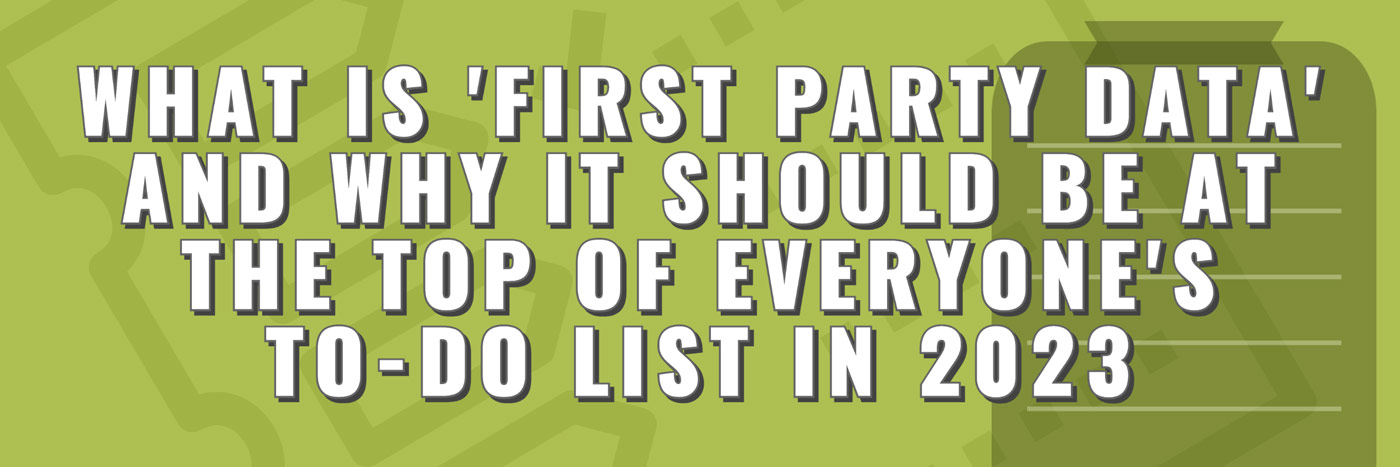The age of third-party is almost over, and businesses need to form a broad perspective via first-party data. Once third-party data is completely out of the picture, first-party data would become the most valuable information for businesses.
The fact is that first-party data paves the way for new opportunities and guide businesses to make their segmentation smarter. Businesses can harness first-party data to personalize customer experiences. In 2023, businesses should not waste and focus on first-party data to generate more online revenue.
Accurate data collection and insights boil down to integration and whether or not you have a targeted approach to personalize messages. The need of the hour dictates that marketers render heightened customer experiences and develop a better understanding of customers using first-party data.
Basics of “First Party Data and What It’s Important
First-party data refers to information any organization can collect straight from their customers. 1P data or first-party data is part of a larger framework when it comes to disposable data for marketers. At its core, digital marketers can enhance, reduce, or complement first-party data.
Recently, first-party data has become an essential element for modern-day marketers. In the cookieless world, companies won’t be allowed to collect third-party data. It means businesses will have to prioritize first-party data. Companies can use first-party data to create content, ads, and experiences that align with individual rather than collective interests.
It is a brave new world where companies can focus on digital interactions, behavior, purchase history, and preferences of individual customers to make their marketing campaigns more targeted. Businesses can leverage first-party data like a mobile app or web behavior, call center or in-store interactions, loyalty status, and purchase history to create and execute a targeted ad for a specific customer.
First-party data falls into declarative and behavioral data. Declarative data refers to the personal data of the audience, while behavioral data is collected based on the activities and actions of visitors on a digital channel or a site. The main first-party data sources include customer feedback, social media, surveys, app or site behavior, online chat, subscriptions, sales conversations, customer service engagement, newsletter or email subscribers, etc.
With these channels, companies can gain accurate insights and improve their business and customer data. Remember, the trick to leverage the most benefits of first-party data is to focus on the right sources to extract the right data.
Cookies and the Change in Third-Party Tracking in Google and Facebook Advertising
Sure, third-party data sources can improve acquisition strategies, but they struggle to paint a clear picture of an individual customer’s relationship with a specific brand and purchase path. And the worst part of third-party data is that companies can sell it to others, creating private and security issues for online users.
It is no secret that third-party data has become more expensive, inaccurate, and compromised in quality. When it comes to empowering consumers, creating targeted and highly personalized experiences to win brand retention and loyalty makes more sense through first-party data.
You can use the same 1P data to understand customer needs, intentions, and wants. Essentially, first-party data comes with contextual relevance and propels businesses to make better use of data. And this, in turn, allows brands to form individual customer interactions.
Consequences of not Building Lead Acquisition Systems
While bidding farewell to third-party is a major shift and may alter the course of digital transformation for companies, it is a step in the right direction. The main pitfall of overlooking first-party data and continuing with third-party data collection would be against the rules and regulations of GDPR.
“I don’t plan to check out a site that does not offer a satisfactory and fulfilling customer experience.” Forrester study
Marketers need to focus on legal and smart ways to collect customer information. Now, like other types of data, 1P data comes with its own challenges. Whether advertising via digital channels or tracking online user behavior, businesses can no longer continue to depend on cookies.
In the coming years, marketers and companies will have to determine how best to utilize first-party data to provide personalized content to customers and prospects. Most marketers are aware that first-party data can generate the highest ROI on any type of data.
“When your brand is attractive, robust, and possesses a multitude of data – it is time to depend on a non-transparent and complex ecosystem to be innovative. Context and content are still at the forefront, and you don’t need a plethora of data to roll out targeted campaigns”. Olivier Simonis on Cookieless digital world
Once marketers and companies discover the true power of 1P data, they soon want to utilize it for multiple purposes. Besides, not every marketer has the newest technologies to take advantage of third-party data and fill the marketing gaps.
“We’ve decided to move forward in a progressive direction and make first-party data our main priority to address customers and get to know them better.” –Website and CRM Marketer, Koen Baltussen, Royal Swinkels Family Brewers.
While there are hurdles to collecting 1P data, the consequences of not following this route can cost businesses more money in fines and penalties. Not to mention, overlooking regulated data collection methods and falling into the trap of third-party data can tarnish the reputation of businesses.
Before using collected data, companies should think about what they want to achieve in the first place. Whether it’s to drive more leads, raise brand awareness, or re-engage with customers, ensure your marketing goals are clear to make the most out of first-party data.
Digital Transformation and CRM: How Businesses Plan to Transition
Google affirms that some technological and organizational elements might make it difficult for some organizations to transition and collect data solely via first-party data.
Regardless, the future is cookie-free and would favor bold digital marketing efforts. Businesses will have to navigate the best practices and tactics to utilize first-party data. Fortunately, most companies understand the long-term value of digital transformation.
Whether it’s personalization, integration, transparency, compliance, improved customer relationships, better control, and accuracy, first-party data comes with a lot of perks, and now it is up to businesses to switch to first-party data collection practices.
Contrary to naïve misconception, first-party data collection doesn’t leave businesses in the dark. Instead, it requires businesses and marketers to be more proactive and strategic in collecting data. For businesses, the digital transformation journey is accelerated and seamless when the focus is on security and privacy. Plus, there should be no compromises on data integrity and governance.
Conclusion
Data still stems from customers, and businesses have a unique opportunity to expand their understanding. It is an effective way to render seamless, uniform, and rich omnichannel customer experiences. Besides, it’s what customers expect from brands now.
You can expect standards to be pushed for years to come. Failure to make data-driven strategies mean customer experience won’t be relevant enough for customers. In retrospect, collecting accurate data is necessary to ensure successful customer journeys.





